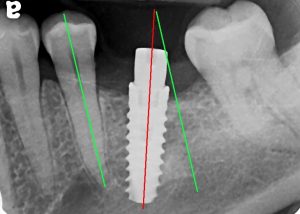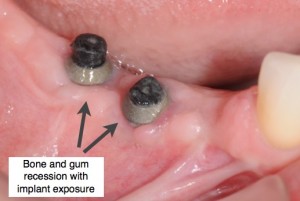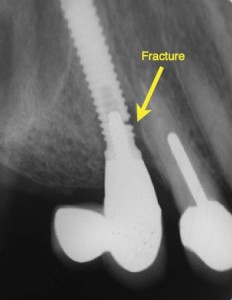
Mal-positioned dental implants:
 Dental implants that are poorly positioned create a number of problems. These include difficulty making the restorations, cosmetic problems, hygiene problems, chewing issues, and longevity. To have long term success, dental implants must be positioned precisely with proper axis, depth, and angle determined by the restoration itself.
Dental implants that are poorly positioned create a number of problems. These include difficulty making the restorations, cosmetic problems, hygiene problems, chewing issues, and longevity. To have long term success, dental implants must be positioned precisely with proper axis, depth, and angle determined by the restoration itself.
Solution: If the implant is slightly off axis, then the restorative dentist can correct the angulation with a customized abutment and crown. If the implant is significantly off axis and simply difficult or impossible to restore, then the implant can be removed and replaced later once the site has healed. The implant can be removed a-traumatically and easily using special tools and techniques. The site of the implant might require minor grafting before replacement with a new dental implant.
The following video will demonstrate our new technique to remove failed dental implants without bone removal (This is a surgical video and is graphic!):
Loose dental implants:
A loose dental implant is indicative of poor healing and non-integration into the bone. Under normal circumstances, the dental implant undergoes a healing process over three to six months during with it fuses with the bone (osseointegration). If the implant is loose, it means it has lost integration with the bone and is no longer in contact with it. This is referred to as a fibrous integration which means there is soft tissue between the implant and the bone. The implant may also be loose simply due to infection and bone loss. This is a failed dental implant.
A dental implant may heal poorly and lose integration due to several reasons:
- Inflammation or infection following surgery
- Poor bone quality
- Inadequate amount of bone
- Micro-motion from loading the implant too early
- Poor surgical technique during placement
- Poor stability during placement
- Over preparation of the site
- Traumatic surgery with poor handling of bone and gum tissue
- Smoking
- Poor oral hygiene
Solution: The implant must be removed as soon as possible. The site should be grafted if possible and prepared for replacement with a new dental implant once it has healed. ‘Watching’ a failing dental implant and hoping it tightens over time is simply unrealistic and does not work. Once an implant has lost its stability and integration, it can not be fixed. It must be removed.
Bone loss around dental implants:
 Bone loss around dental implants is an irreversible process that leads to gum recession and ultimately exposure of the implant surface. This process is similar to periodontal or gum disease where the bone is gradually lost. Bone loss around dental implants may be caused:
Bone loss around dental implants is an irreversible process that leads to gum recession and ultimately exposure of the implant surface. This process is similar to periodontal or gum disease where the bone is gradually lost. Bone loss around dental implants may be caused:
- Inflammation (peri-implantitis)
- Poorly positioned dental implants
- Overload of mal-positioned implants from excessive forces during chewing
- Adjacent teeth with gum disease
- Poor oral hygiene resulting in plaque / calculus formation.
Solution: Once bone has been lost around a dental implant, it can not be repaired. Bone grafting is often unsuccessful in achieving coverage. The implant must be removed and the site grafted for replacement with a new dental implant at a later time. Any teeth with existing gum disease next to a dental implant should be treated to optimize the health of the surrounding tissues.
Dental implant infection / inflammation:
Dental implant infection or inflammation (peri-implantitis) is characterized by pain and swelling of the gum tissue surrounding the implants. The most common cause of long-term pain around dental implants is peri-implantitis (inflammation around the implant) that develops from plaque around the implant or its surface; the plaque sticks tightly to the implant’s rough surface making its removal impossible. This in-turn results in chronic inflammation or infection that leads to further bone and gum tissue loss and eventual implant failure. Another reason for chronic dental implant pain is non-integration that means the implant has not healed in the bone as expected. Following restoration of the implants, the restorative dentist should do check up and cleaning every three to six months depending on the need of an individual. Patients should follow oral hygiene instructions given by the restorative dentist and keep their teeth and implants clean at all times. The symptoms of infection or inflammation are pain, gum tissue swelling, bleeding, and pus. For more information, see: “The Painful Implant- Peri-implantitis”
Solution: Mild and acute inflammation may respond well to a professional cleaning and better home care. However, persistent inflammation or infection requires surgical intervention. If there is an infection, antibiotics may help temporarily. Bone grafting and tissue grafting are unpredictable and may be effective in rare cases. With persistent inflammation or infection the best option is to remove the implant, restore the missing bone and replace with a new dental implant.
Dental implant fracture:
 Dental implant fractures are extremely rare but do happen. The primary cause of dental implant fracture is a loose crown or abutment and continued biting and chewing. The forces of chewing can result in fracture of the holding screws or the implant itself. Any loose crowns or components should be checked immediately by your dentist and tightened to prevent damage to its foundation.
Dental implant fractures are extremely rare but do happen. The primary cause of dental implant fracture is a loose crown or abutment and continued biting and chewing. The forces of chewing can result in fracture of the holding screws or the implant itself. Any loose crowns or components should be checked immediately by your dentist and tightened to prevent damage to its foundation.
Solution: If the screw holding the crown / abutment to the implant is fractured, it might be possible to remove it and replace with a new screw. If the implant is fractured, then the implant must be removed, grafted if necessary, and replaced with a new dental implant at a later time.
